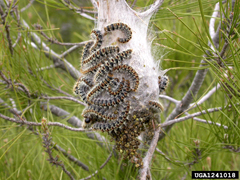Common Name
Pine Processionary Moth
Latin Name
Thaumetopoea pityocampa
Main Host(s): Pine (Pinus sp.), Cedar (Cedrus sp.) and occasionally European larch (Larix decidua)
Life Cycle
The Pine Processionary moth produces normally one generation per year, but its lifecycle may extend over two years at higher elevations or in northern latitudes. It prefers to feed on Pinus sp. especially P. sylvestris and P. nigra while other species like Cedrus atlantica and Larix deciduaare less susceptible.The life cycle of the Pine Processionary Moth includes two locations: the egg, caterpillar and the adult moth stages can be found on foliage, while the pupal stage is underground. Development of the insect normally lasts about six months, but the 4th and the 5th instars may be prolonged in the winter. The unseen pupal stage can also last longer by diapause dormancy.

In most ecological conditions, adult emergence occurs in July. The female moth lays her eggs (70-300) in cylindrically shaped egg masses around pairs of needles a few hours after emergence from the pupal stage and mating. After 30-45 days, the larvae aggregate in colonies and build large unsightly “nests” comprised of webbing and clipped needles. The larvae populate these nests all winter but venture out after sunset to feed overnight on foliage, returning at dawn.At the end of the winter or early in the spring, the larvae start their ‘procession’ in long ‘head to tail’ type columns moving to the ground for pupation; they will undergo diapause at a depth of about 10 cm in the soil. One month later, most of the pupae will emerge as moths while some will extend their diapause for a year or longer.
Impact & Damage
Pine Processionary Moth is considered one of the most important forest pests in southern Europe, especially in the Mediterranean region where it is commonly observed in pine forests. It is also observed infesting the cedar forests of North Africa.The larvae feed on the needles close to the nest causing defoliation, especially during the winter months. The larvae can also cause serious health problems for humans and animals as the caterpillars have long urticating hairs (irritating bristles) which may cause allergies and respiratory issues amongst humans and animals.This health effect is common to many caterpillar species. For example, in the presence of large numbers of tussock moths, an allergic reaction known as ‘tussockosis’ can occur which is caused by the urticating hairs of tussock moths.
Resources
Learn more about Pine Processionary Moth
Quick Links
Contact a Valent BioSciences public health representative.
Contact Us